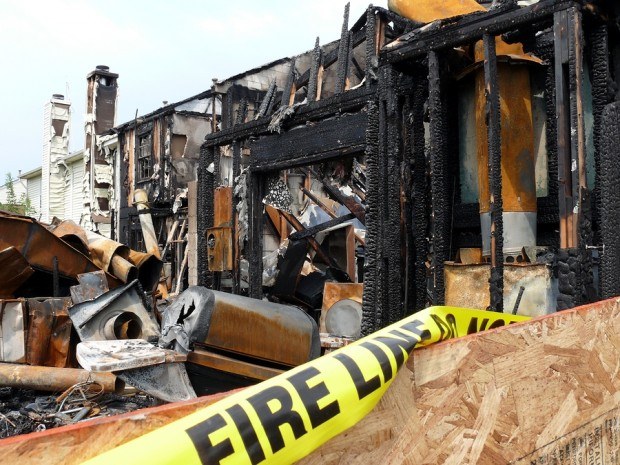Television networks are tapping into a mounting challenge affecting many U.S. homeowners: rebuilding after disasters.
Rachael Ray — the chef whose TV programs on quick dinners gained popularity in the early 2000s — has created a new show called “Rachael Ray’s Rebuild” that’s focused on fixing properties after floods, tornadoes and even catastrophes not caused by weather, such as house fires. It’s part of the push by television networks into shows to help owners address complicated parts of maintaining homes, such as HGTV’s “Renovation 911” program that debuted earlier this year.
The shows are one sign that the rise in extreme weather events, often driven by climate change, is seeping into the mainstream conversation about homeownership. Now, the U.S. experiences one billion-dollar disaster every three weeks on average, up from one every four months in the 1980s, according to the fifth National Climate Assessment.
It’s infiltrated the homebuying process with listing sites such as Redfin Corp. and Realtor.com including measures on flood and wildfire risks. Even builders such as Homebound are finding ways to help rebuild homes hit by disasters.
Ray faced two disasters herself. In 2020, a chimney fire burned down her upstate New York home. Just a year later, her New York City apartment flooded twice: first from Hurricane Ida, and then when someone busted a pipe as they were surveying the storm’s damage.
The lack of disaster recovery shows sparked the interest of Brian Flanagan, the executive producer behind two of Ray’s previous projects and titles such as HGTV’s “Beachfront Bargain Hunt.”
“I said, ‘There’s something going on in the world, Rach, where if you turn on the news you’ll see homes destroyed by disaster all the time. You just suffered two of them,'” said Flanagan, recalling a phone call with Ray. “I think with you at the helm, if you’re interested in helping people, there would be an audience for this.”
Bouncing Back
The 10-episode show, which is streaming on Hulu, touches on a range of disasters, from tornadoes to mold and a fire sparked by a candle, in an effort to cover a definition of disasters broader than just ones spurred by climate change.
“The choice of disaster was simply that. It was, ‘People suffer home disasters for all sorts of reasons, and when you face one, how do you recover from it and move back home?'” Flanagan said. “From a TV producing standpoint, we want the casting net to be as wide as possible, and sadly there’s a lot of people who suffer from these disasters.”
Some experts say the show leaves out some important rebuilding strategies. For example, the episode featuring a tornado-damaged home could have benefited from instructions on installing a storm shelter, said Anne Cope, chief engineer of the Insurance Institute for Business & Home Safety. Flanagan, an executive producer on the show, noted that the program does explain how a basement can be a safe space if future disasters occur.
The show also doesn’t talk about relocating, particularly in the case of floods where recurrence is inevitable and often difficult to protect against, Cope said. It also doesn’t feature green building techniques, which would help cut down on emissions that contribute to worsening storms, according to Carolyn Kousky, associate vice president for economics and policy at the Environmental Defense Fund.
Flanagan said the show aimed to focus on families who want to return home and producers wanted to keep the show entertaining and not too bogged down with specifics on building techniques.
On the program, funds from the Ray and her partner brands, as well as the TV networks, help to offset some of the costs of rebuilding. When combined with contracting expertise from costar Anthony Carrino, what is often an expensive, years-long process boils down into a few weeks.
A growing number of homeowners are shouldering this process with limited support. Over the last year, nearly 2.5 million people in the U.S. have been forced from their homes by natural disasters, with 5 percent reporting being displaced for more than six months and roughly 20 percent saying they never returned, according to a U.S. Census Bureau survey. Americans spent $18 billion on disaster repairs in 2021, up from $15 billion a decade ago, according to the Harvard Joint Center for Housing Studies.
Rebuilding is often made more complicated by the current state of the housing market. Mortgage rates have shot up and are now hovering above 7 percent for a 30-year, fixed loan, squeezing affordability. Listings have been in short supply as few owners want to give up lower interest rates. Those issues can be exacerbated after a storm destroys a region.
“When you’ve invested in a home, you may have no economic alternative but to rebuild,” said Jesse Keenan, professor of sustainable real estate at Tulane University in New Orleans. “If you just sell a property with a destroyed home on it, you’re going to have a loss. And good luck in a post-disaster context trying to find a house.”
First Step
Ray’s show leans into practical advice for owners needing to renovate by offering lessons on insurance coverage and explaining the rationale behind disaster-safe design strategies. Carrino said he aimed to set this show apart from its more makeover-centered predecessors by walking viewers through creative repair techniques.
“Everybody is so enthralled with the pretty pictures of it all that they forget that the audience needs a little education,” Carrino said. “I love the transformation, too, but there are takeaways to be had that don’t take away from the fun or visuals that would actually give the viewer the ability to go, ‘That’s something I’ll remember, maybe that’s how I’ll do it if I ever encounter this circumstance.”
The episodes are taking a notable first step by spurring conversation about rebuilding after disasters, according to Carlos Martin from the Harvard Joint Center for Housing Studies.
“The beauty about these TV shows is that they create awareness,” Martin said. “It’s an entry point to plant a seed in somebody’s head that you know, ‘Maybe we should be thinking about doing something else to our home, making sure we have the right insurance, making sure we know what the process will be if something happens.'”





















 Chubb, The Hartford, Liberty and Travelers Team Up on Surety Tech Co. Launch
Chubb, The Hartford, Liberty and Travelers Team Up on Surety Tech Co. Launch  How Carriers Are Pairing AI and Process Discipline to Drive Subrogation Outcomes
How Carriers Are Pairing AI and Process Discipline to Drive Subrogation Outcomes  Executives on the Move at HSB, American Modern Insurance Group, AIG
Executives on the Move at HSB, American Modern Insurance Group, AIG  The Hardest Part of Innovation in Insurance Isn’t Technology; It’s Culture
The Hardest Part of Innovation in Insurance Isn’t Technology; It’s Culture 